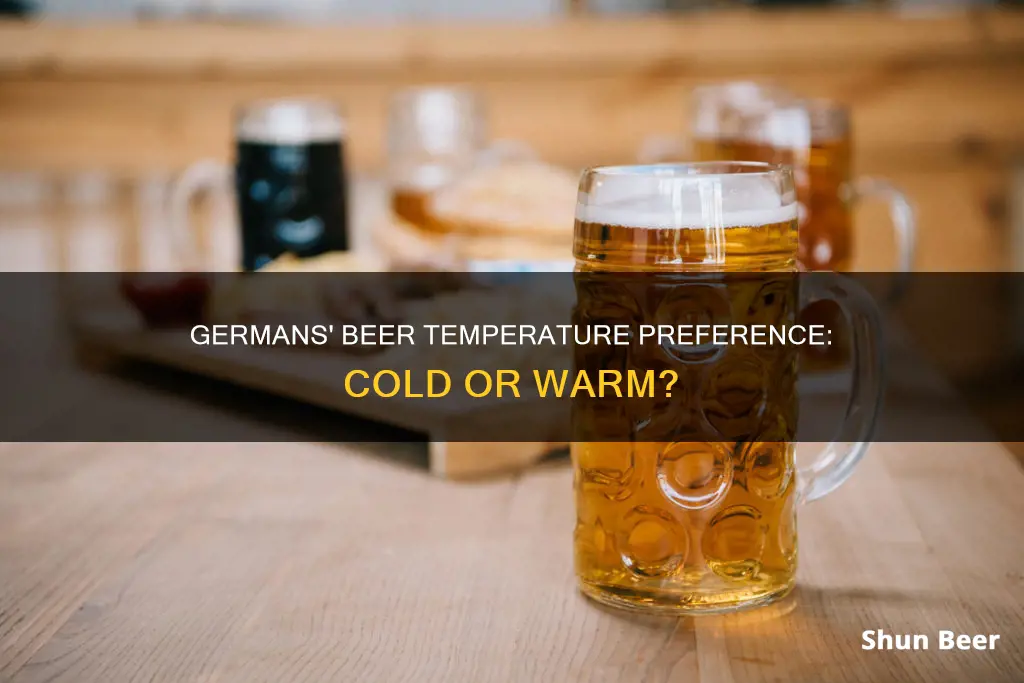
There is a common misconception that Germans drink warm beer. This is likely due to the fact that German beers are served at a slightly higher temperature than in the US, where beer is often served almost freezing and in a chilled glass. The optimal drinking temperature for beer served at Oktoberfest in Munich, for example, is 8°C (46.4°F). In Germany, ales are typically served between 40 and 50°F, which is considered warm by American standards but is actually closer to the temperature at which beer tastes better and is more enjoyable.
What You'll Learn

German beers are served warmer than American beers
German beers are served slightly warmer than American beers. While Americans tend to serve their beers almost frozen, and in a chilled glass, German ales are typically served between 40 and 50 degrees Fahrenheit. This is still far from being a warm beverage, but compared to the American preference, it is noticeably less cold.
The myth that Germans drink warm beer likely stems from the fact that beer is traditionally brewed on the warm side. Ales, for example, are brewed with ale yeast, which ferments best at temperatures between 60 and 78 degrees Fahrenheit. This warmer temperature enhances the flavours and aromas of the beer, which are stunted at colder temperatures.
Lagers, on the other hand, ferment at much colder temperatures. Some lagers are considered virtually flavourless, and are therefore often served ice-cold. This trend has carried over to American drinking culture, where most beers are served at freezing temperatures.
In Germany, it is not uncommon for some people to enjoy their beer warmed up, especially during the colder seasons. In the past, bars in Germany kept ceramic-coated immersion heaters that could be plugged in and stuck into a glass of beer to warm it up. However, these heaters were eventually outlawed, possibly due to safety concerns. Nowadays, some bars in Germany keep beer warming buckets, which are used to slightly increase the temperature of a beer so that it is not too cold to drink in winter.
The optimal drinking temperature for beers served at Oktoberfest in Munich, for example, is 8 degrees Celsius (46.4 degrees Fahrenheit). This is notably warmer than the freezing temperatures preferred by many Americans.
Does Beer Make Breasts Bigger?
You may want to see also

Warmbier is a traditional German drink
The tradition of drinking Warmbier in Germany dates back centuries, with mentions of it in 18th-century texts such as Johann Georg Krünitz's "Oeconomische Encyclopädie." In the past, it was a common practice to serve beer slightly warmed, and this tradition has persisted in modified forms today.
While Germans do not drink their beer ice-cold, they also do not drink it warm. German beers are typically served at a cooler temperature than American beers, usually between 40 and 50 degrees Fahrenheit. This is because colder temperatures can stunt the flavours and aromas of the beer, while a slightly warmer temperature can enhance them.
The myth that Germans drink warm beer may have stemmed from the traditional practice of warming beer to enhance its flavour and the existence of Warmbier as a historical beverage. However, it is important to note that even in Germany, the optimal drinking temperature for beer is still cool, just not freezing.
In conclusion, while Warmbier is a traditional German drink, it is not representative of how Germans typically consume their beer today. German beers are served at cooler temperatures than in the United States, but they are not served warm. The myth of Germans drinking warm beer is likely a result of cultural differences in beer-serving temperatures and the historical existence of Warmbier as a winter beverage.
Champagne and Beer: Mixing Drinks, Safe or Not?
You may want to see also

Beer is traditionally brewed on the warm side
It is true that beer is traditionally brewed on the warm side. Ales, which have been around for more than 10,000 years, are brewed with ale yeast, which ferments optimally at temperatures between 60 and 78 degrees Fahrenheit. This is considered quite warm, and the reason for this temperature is that it enhances the flavours and aromas, which are stunted at colder temperatures.
Lagers, on the other hand, are a much more recent development, having been introduced only about 600 years ago. Lagers ferment at much colder temperatures, and while some are quite flavoursome, others are considered rather flavourless and are usually drunk ice cold. Serving these beers at a warmer temperature tends to bring out undesirable notes. This trend has carried over to American beer drinking culture more broadly, where beer is typically served at very cold temperatures.
In reality, many beers taste better and are more enjoyable at a warmer temperature, closer to 50 degrees Fahrenheit. German beers, for example, are served a bit warmer than American beers. While Americans tend to serve their beers almost frozen and in chilled glasses, German ales are typically served between 40 and 50 degrees Fahrenheit. These temperatures are not warm by many standards, but because Americans are so used to ice-cold beer, the myth has persisted that Germans drink warm beer.
In fact, there is some historical basis for drinking warm beer in Germany. In the 18th century, Johann Georg Krünitz’s Oeconomische Encyclopädie mentions:
> “Warm beer is a drink that our grandparents enjoyed in the last century, and at the beginning of the present, almost in the same way as we now serve coffee, and with better benefits for their health.”
The recipe for this drink, known as "warmbier", called for the beer to be warmed and mixed with eggs, flour, butter, ginger, nutmeg, sugar, and salt. Although warmbier is not very popular in Germany today, some Germans still drink it during the cold season. Another notable mention is Glühbier, which is basically mulled beer and is served warm around Christmas.
Walking Your Dog With a Beer: Is It Legal?
You may want to see also

Germans use beer warmers to slightly increase the temperature of beer
While Germans do not drink warm beer, their beers are served slightly warmer than American beers. Typically, German ales are served between 40 and 50 degrees Fahrenheit, while Americans tend to serve their beers at near-freezing temperatures and in chilled glasses. This difference in serving temperature has likely contributed to the myth that Germans drink warm beer.
In Germany, it is common for some people to enjoy their beer slightly warmed up, especially during the cold season. This practice is supported by the use of beer warmers, which have been a part of German culture for centuries. A beer warmer is a narrow metal tube filled with hot water and closed with a lid. It is then suspended in a glass of cold beer to bring the temperature up slightly. These beer warmers have been traditionally given as gifts during the holidays.
The preference for slightly warmer beer in Germany may be due to the belief that colder temperatures stunt the flavours and aromas of the beer. Ales, for example, which have been brewed for over 10,000 years, are brewed with ale yeast that ferments best at temperatures between 60 and 78 degrees Fahrenheit. On the other hand, lagers, which are a more recent addition, ferment at much colder temperatures.
While most Germans do not drink their beer warm, there are a few exceptions, such as "Warmbier" and "Glühbier." Warmbier is a traditional drink where beer is warmed up and mixed with eggs, flour, butter, ginger, nutmeg, sugar, and salt. It is not as popular nowadays, but some Germans still enjoy it during the colder months. Glühbier, or mulled beer, is another example of a warm beer drink that is served during Christmas.
Beer and Meclizine: Is It Safe to Drink Alcohol?
You may want to see also

Beer served at Oktoberfest is cold but not half-frozen
It is a common misconception that Germans drink warm beer. While German beers are served at a warmer temperature than American beers, they are not warm. Typically, German ales are served between 40 and 50 degrees Fahrenheit, which is certainly cooler than room temperature.
This myth may have arisen due to the existence of warmbier, a drink that was popular in Germany in the 18th century. This beverage consisted of warmed beer mixed with eggs, flour, butter, ginger, nutmeg, sugar, and salt. While not as popular today, some Germans still enjoy this traditional drink during the colder months. Another similar drink is Glühbier, which is mulled beer served warm at Christmas.
Additionally, in very cold weather, some Germans may use a beer warmer to slightly increase the temperature of their beer so that it is not freezing cold. This practice is also observed in other Central European countries. However, it is important to note that the beer is still intended to be consumed cold, just not ice-cold.
During the annual Oktoberfest celebration in Munich, only beer from local breweries is served. The festival features six breweries: Paulaner, Spaten, Hacker-Pschorr, Augustiner, Hofbrau, and Lowenbrau. The beers served at Oktoberfest are cold, but not half-frozen. According to festival rules, each beer served must have a minimum alcohol content of 13.5% Stammwürze (approximately 6% ABV) and must be "pure," containing only water, barley, hops, yeast, wheat malt, and/or cane sugar.
Beer and Vaccines: A Day's Gap is Enough
You may want to see also
Frequently asked questions
No, Germans do not drink warm beer. However, German beers are served slightly warmer than American beers. While Americans tend to serve their beers almost frozen, German ales are typically served between 40 and 50 degrees Fahrenheit.
Ales, the kind of beers that have been around for more than 10,000 years, are brewed with ale yeast, which ferments best at temperatures between 60 and 78 degrees Fahrenheit. Serving ales warmer enhances their flavours and aromas, which are stunted at colder temperatures.
Yes, there are two exceptions. The first is Warmbier, a drink that was popular in the 18th century and is still enjoyed by some Germans during the cold season. It involves warming up beer and mixing it with eggs, flour, butter, ginger, nutmeg, sugar, and salt. The second exception is Glühbier, which is basically mulled beer and is served warm during Christmas.
Yes, the preference for drinking beer at slightly warmer temperatures extends throughout Central Europe. In the winter, it is common for Europeans to warm up their beer slightly so it is not too cold to drink.







